The Best New York Style Pizza Dough and 14 Tips for Success!!
I’ve been making a lot of this NY style pizza dough recipe …. The obsession started a while back, and I’ve finally found a recipe that I love the best! After years of experiments (and I mean years!), I am now using this recipe based on recommendations from the many fine pizza makers at www.pizzamaking.com and the late great Dough Doctor, Tom Lehmann.

Making Pizza Dough at Home
Making NY style pizza dough is definitely somewhat of an art form. There are so many variables that can be changed aside from the ingredients alone. For example, these variables include:
- oven temperature
- temperature of the water used to make the dough
- proofing methods (room temp vs cold rise)
- order of adding the ingredients (yes, this makes a big difference!)
- mixing time
- use of autolyse
- use of poolish (I don’t do this or the one before, although I have in the past)
And then of course, the toppings which can be simple or as complex as you’d like. But don’t worry too much about all of this – my method is easy and straightforward. Plus, you will make better dough than 99% of the pizza chains out there. You will not want take out anymore!
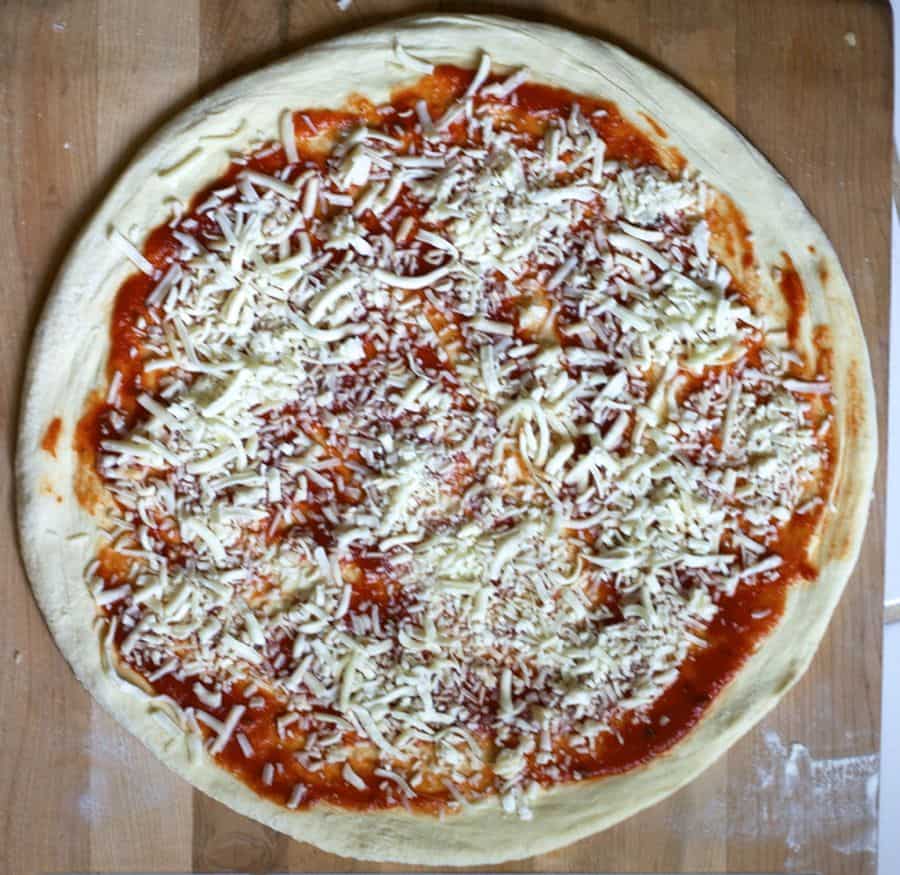
My Favorite Pizza Dough: The Big Secret (How You Proof the Dough)
My all-time favorite dough is NY style dough, which really is classic pizza dough that is stretched out into a thin crust pizza. This type of pizza dough contains water, flour, salt, instant yeast, and olive oil (and sugar especially when baking in a home oven, to help browning).
After it is mixed, it is proofed (left to rise/ferment) in the refrigerator for a minimum of 24 hours and up to 72 hours (it can also be frozen) – this is the big secret. I’ve used the dough up to 5 or 6 days afterwards, so you can essentially prepare dough for the week.
This recipe produces a crisp yet foldable crust that is tender, light, and flavorful and will make enough for four 14-inch pizzas. You can easily double or half the recipe to make 2 or 8 pizzas.

Fourteen Tips for Success
Tip 1: Choosing the flour
Use high-quality flour – I like to use King Arthur’s all purpose or bread flour; higher protein (ie, bread) flours work best. However, I prefer all-purpose flour because I like a lighter, airy crust.
Tip 2: Adding the yeast
Do not add instant dry yeast (IDY) directly to cold or cool water – you may shock the yeast (add the IDY to your flour instead) (please note that IDY differs from active dry yeast, which must be activated by adding it to water).
Tip 3: How much yeast?
Use only enough yeast to “get the job done” – yeast eats the sugar in your flour to produce its leavening effects – I find that if you use too much, your dough will be tasteless (this is just my opinion); however, it is a fact, that too much yeast can make your dough taste bad. Most recipes out there, some of them in well known, published books contain too much yeast!
Tip 4: Cold ferment that pizza dough!
Always use your refrigerator. The best NY style doughs “ferment” or “cure” in the refrigerator for at least 24 hours and up to 48 72 hours. This is called a “cold rise” (vs warm rise on your kitchen counter).
The refrigerator is used to retard (or slow) the dough’s fermentation, allowing that distinctive flavor to come through (ever wonder why some pizza crust tastes different than others, despite the fact that they are both made from just about the same exact ingredients? – this is a big reason why!)
When your dough rises too quickly, the flavor will not develop optimally. Slow rise = MUCH better flavor.
Tip 5: Weigh those ingredients!
Use a scale to weigh the flour instead of using a measuring cup – it is much more accurate and will yield superior results. I’ll admit, I resisted doing this for a loooong time. Just do it. You’ll be glad you did and your dough will be more consistent and much improved.
Tip 6: Add oil last
Mix the oil in as the last step, after the flour has all been incorporated. This is important to allow the flour to hydrate properly.
Tip 7: Flour your dough balls
Before tossing or opening your dough balls, flour them *very* well on each side (if you are a beginner) to ensure they do not stick to your counter or pizza peel. I sometimes use a bit more flour after I begin spreading them.
Tip 8: Keeping those rims a bit puffy
Take care not to “degas” the rim of your pizza as you are spreading your dough! Do NOT ever use a rolling pin! There are many different methods to spread/open your dough ball. I hope to add a few pictures someday of this process.
Tip 9: Baking pizza in a home oven
Ensure that your oven is preheated for a sufficient amount of time (about 1 hour) and bake the pizza within 6 to 8 inches of the top of your oven (ie, your broiler) so that the tops browns sufficiently in conjunction with the bottom of the pizza.
Do not place the stone near the bottom of your oven. I made this mistake for too many years.
After your stone has been preheated sufficiently, the heat from the stone will cook the pizza from the bottom and you can switch the broiler on if you find you need more browning on the top (I now use the broiler to bake my pizzas…more on this sometime in the future).
If you find that your cheese is browning well before your rim attains sufficient color, use partially frozen cheese (ie, place shredded cheese in the freezer while the oven is heating up) and cold sauce or you can drizzle just a bit of olive oil on top of cheese.
Tip 10: Use a pizza stone or steel
Use a pizza stone if you have one. The stone with draw moisture out of the dough and produce a beautifully crisp crust. I use a pizza steel because my stones kept breaking.
Tip 11: Use just the right amount of sauce
Do not use too much pizza sauce – it will make your pizza soggy
Tip 12: Find the right kind of cheese
Do not use low fat cheese to top your pizza or pre-shredded cheese (the former will not melt sufficiently and the latter contains additives that prevent the cheese from sticking together and therefore does not melt very well). The best is low-moisture, whole milk mozzarella.
If you must use pre-shredded cheese, I’ve found that adding the sauce on top of the cheese helps with the melting. Also, do not use too much cheese; apply it sparingly so that you can achieve that mottled NY pizza appearance.
Tip 13: Flour your pizza peel
Use semolina or flour on the bottom of your pizza peel to prevent the pizza dough from sticking but be careful not to overdo it because it will burn.
Tip 14: Learn to launch that pizza
Give the pizza peel a few very small quick jerks to make sure the pizza will easily slide off your pizza peel before attempting to transfer pizza to the oven, and more importantly, rub flour into the peel before placing the dough on top.
Essential Equipment
Please note that as an Amazon affiliate, we earn a small commission if you purchase a product at no additional cost to you.
I adore my baking steel; it’s transformed my home pizzas into restaurant-quality and better. You will love this! A kitchen scale streamlines measurement with remarkable accuracy, while a pizza peel is essential for smoothly sliding pizzas into the oven. And proofing boxes provide an optimal storage for pizza dough fermentation, enhancing flavor, texture, and elasticity.
Please visit our SHOP page for more recommended tools and equipment to make restaurant-style NY-style pizza at home!
How to Stretch the Pizza Dough
A nice video (from The GoodFellas Pizza School of NY), showing how to stretch the dough:

How to Freeze Homemade Pizza Dough
- After mixing dough and dividing into balls, place dough in refrigerator for at least 24 hours.
- Place dough balls on baking sheet lined with plastic wrap or parchment paper, cover loosely with plastic wrap and freeze until firm (~ 2 to 3 hours or up to overnight).
- Wrap frozen dough balls individually in plastic and store in zipper-lock bags for up to 4 weeks.
- When ready to bake, transfer unwrapped dough into the refrigerator for 12 to 24 hours before making pizza.
- Bring dough to room temperature for 20 to 60 minutes before baking (less time for hot kitchen/summer and more time for cool kitchen)
Pizza Dough Calculator
Need more dough? Less dough? Try out our new Pizza Dough Calculator to calculate the weights to get it just right!
Have More Questions?
Please See My NY Pizza FAQ
If you tried this recipe, please leave a 🌟 star rating and let me know how it went in the 📝 comments below! SUBSCRIBE for more recipes.
📖 Recipe

The Best New York Style Pizza Dough
Equipment
- pizza stone or pizza steel for baking
- Standing mixer optional or hand knead
- kitchen scale highly recommended instead of volume measures
Ingredients
Original Recipe for Four 14-Inch Pizzas; want to make more or less? Use the pizza dough calculator
- 6.5 cups (796 g) all purpose flour or bread flour (weighing is most accurate!)
- 2 1/4 cups (493 g) water barely cold water (17.4 oz per 2 1/4 cups)
- 1 teaspoon (3.5 g) instant dry yeast
- 2.5 teaspoons (15.6 g) salt
- 2 teaspoons (7.8 g) sugar
- 1 tablespoon (11.8 g) olive oil
1 Pound of Dough (~454 grams) (use the pizza dough calculator to make more or less dough)
- 2 1/4 cups (274.5 g) all purpose flour or bread flour
- 3/4 cup (170.2 g) water
- 1/2 teaspoon instant dry yeast
- 1 teaspoon salt
- 3/4 teaspoon sugar
- 1 teaspoon olive oil
Instructions
Mixing the Dough
- Place water in mixing bowl.
- In a separate bowl, mix salt and yeast (and sugar if using) into flour
- Combine flour/salt/yeast mixture into water and mix until all the flour has been incorporated.
- After flour has been totally incorporated, add oil and knead for about 4 to 5 minutes (see note)
- Test final dough temperature, which should ideally be between high 70s to low 80s (optional)
Dividing and Rising
- Divide dough into 4 equal pieces (using a digital scale if possible; each ball should weigh 11.5 oz [~326 grams]), shape into a ball, and place in greased, sealed quart-sized container or oiled/greased freezer bag and refrigerate overnight or up to 72 hours (After much experimenting, I have concluded that I like 3 days best but day 2 is good too).
Assembly and Baking
- The following day, remove your dough balls within 1 hour or less of baking and allow the dough to come to room temperature. (the dough will tend to blister more if the dough has not been allowed to come to room temperature however, I often bake coldish dough without problems, just some bubbling)
- In the meantime, place your pizza stone in oven and preheat at 550 degrees (depending on thickness of your stone and your oven’s power) for at least 1 hour
- Open each dough ball using care not to degas, transfer to a pre-floured pizza peel (or on parchment paper), and top with your favorite sauce, cheese, or other toppings.
- Transfer pizza from peel to oven or slide parchment paper onto preheated pizza pan/stone and bake for 4 to 6 minutes each until browned on top and cheese has melted but not burned.
- Enjoy!
Notes
- Use of weight based measurements is highly recommended instead of US Customary. You will need a kitchen scale.
- METRIC amounts DO NOT correspond exactly to the US Customary amounts because, for example, 796 grams equals 6.4 cups (and most can’t measure 0.4 cups or 0.22 cups). Recipe was based on grams.
- Use the Pizza Dough Calculator
- If you want to use the dough the next day, knead a little more (slow speed for about 8 to 10 minutes)
- If you have time to let the dough rest for 3 days, knead for 4 to 5 minutes, low speed or hand knead.
- After mixing dough and dividing into balls, place dough in refrigerator for at least 24 hours.
- Then, place on baking sheet lined with plastic wrap or parchment paper, cover loosely with plastic wrap and freeze until firm (~ 2 to 3 hours or up to overnight).
- Wrap frozen dough balls individually in plastic and store in zipper-lock bags to store for up to 4 weeks (longer may work, but results might vary).
- Before using, transfer unwrapped dough into the refrigerator for 12 to 24 hours before making pizza.
- Bring dough to room temperature for 20 to 60 minutes before baking (less time for hot kitchen/summer and more time for cool kitchen).
- calculate your own using baker’s percentages: 62% hydration, 0.4% yeast, 2% salt, 1.5% oil, and 1% sugar or use my new pizza dough calculator.
Nutrition
Try these other pizzas and this NY pizza sauce:
Buffalo style (one of my absolute favorites)
White with prosciutto
White with spinach and feta
Pizza sauce

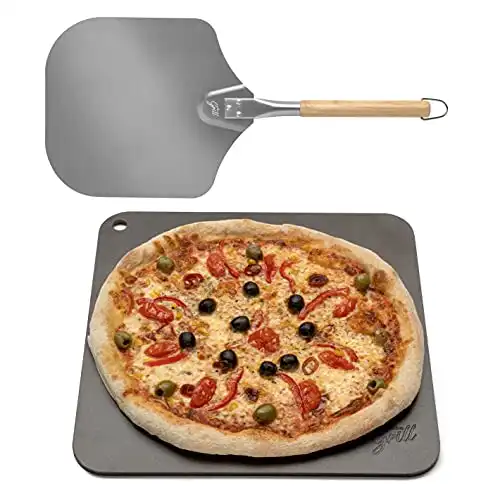
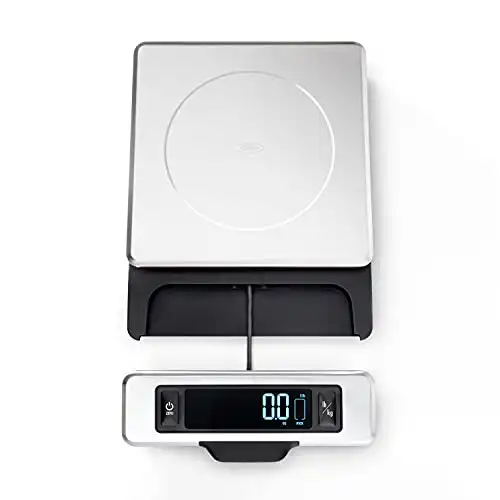
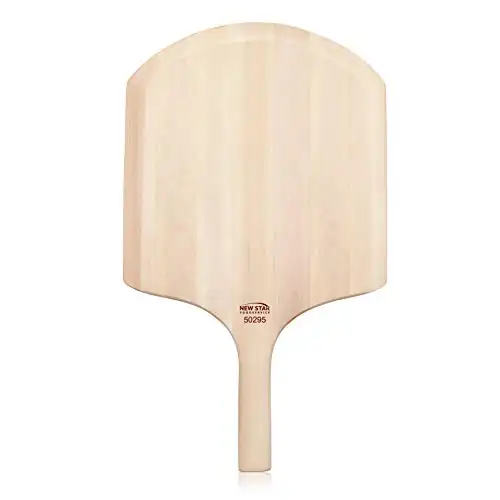
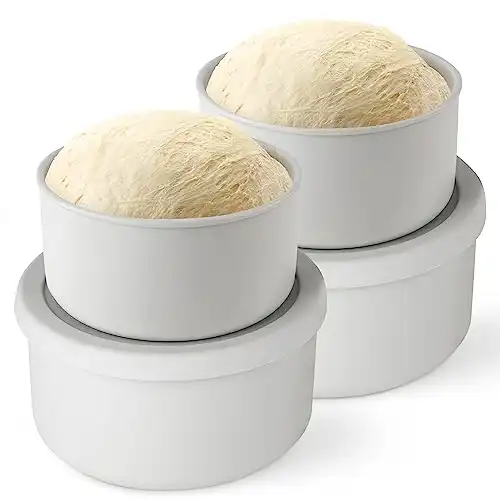
Hi Marie..TX for the recipe! Does moving the pizza stone to the top of the oven apply to a gas oven or only to an electric ? Thanks
I’ve had both kinds of ovens (gas and electric) over the years, and it works for both in my experience.
Hi, just a little confused about the number of pizzas the recipe will bake. You’ve listed 2-14″ pizzas if halved and 2-14″ pizzas for 4 balls of dough. I made a similar recipe and can’t wait to use yours as I’m new to this. Thanks so much for posting it.
Hi Debbie – I mean to say that if you cut the recipe in half, you will have 2 balls of dough and if you make the whole recipe you will have 4 balls of dough – I hope that makes more sense?
I did this recipe exactly as written, except i only had generic unbleached flour on hand. This a great pizza dough recipe. Pie turned perfect. Putting pie up high in oven is a valuable tip. Thanks for that. I use pace picante mild as sauce and i sprinkle pizza seasoning over it, it is surprisingly delicious and a little spicy.
oooh..sounds good! yes, placing the pizza up high was a game changer for me! it helped my pizza crust to look like this – that was super high/close to broiler (but broiler was off). I’ve been using my BlackStone for a while now but I’ll have to get back to baking in my home oven too
This recipe and website are amazing. I plan to make this pizza dough recipe for the second time soon. I have fine pastry flour instead of all-purpose flour. Do you think the dough will still come out correctly?
I’m afraid not…the key to a good pizza is a high protein flour. Pastry flour is low protein and useful when you want a very tender, delicate pastry. So the short answer is definitely no pastry flour – You should use a flour with a protein content of 11% or higher (Gold Medal all purpose, King Arthur all purpose, and Bob’s Red Mill all purpose flours and all bread flours). You can get a general idea by dividing the protein on the nutrition label by the serving size (eg, 3 grams protein per serving/30 grams flour per serving) and then multiplying by 100 to get the percentage. This isn’t 100% accurate though because companies are allowed to round information on their nutrition label (so even though it may have 2.8 grams of protein per serving, they are allowed to say 3 grams) – hope this wasn’t too much info!
As someone who grew up in the Bronx, NY in the 1980’s, I was privilege to have so many great pizza shops around me growing up. I’m going to try this recipe and see if it reminds me of the good ol days! 🙂
I bet those pizzas were amazing! The dough is only part of the puzzle though…do you have a good pizza stone or baking steel? Also make sure your oven is preheated very well with the stone/steel in it (unless you happen to have a pizza oven)
Is it possible to use fresh yeast instead of instant dry?, If so how much fresh yeast should I use for this recipe?
Hi, yes – see this table for conversion. fresh yeast is also referred to as cake yeast in the US, so please see cake yeast
The recipe says it will make four 14″ pizzas or
can be divided in half to make two 14-inch pizzas. I’m confused with that, is the yield 4 or 2 – 14″ pizzas?
Sorry for the confusion – I mean to say that if you only need 2 pizzas, just make half of the recipe. So use 3 cups flour instead of 6 cups and so on
What is best way to form the pie. My cold dough rise is 2x in size with a lot of gas. Any suggestions? What works best?
There is a video on the recipe page that gives one example of how to form the pizza pie…I’ve had dough that has doubled, so that’s fine and lots of gas is good! See if the video helps. you should bring the dough to room temp first or it will be very hard to stretch and cold dough in the oven will form huge bubbles
2.5 teaspoons Salt (15.6 grams) (15.6 grams)
2 teaspoons Sugar (7.8 grams) (optional but highly recommended)
Copied from above recipe
Hi I am confused by your recipe on sugar, and salt in grams. Pls correct me if I am wrong
Hi Nancy – yes, I see it shows twice (15.6 15.6) – you can ignore the second one I’ll delete it now. I think there was a glitch with the website. I often use volume measure only for salt and sugar because it’s faster (although weighing flour is faster than measuring volume). Does that help?
Sorry!
My question if sugar is 2 tsp = 7.8 grams
Why salt 2.5 tsp salt =15.6 gram
1 tsp = 4 gram
Salt for 2.5 tsp should be 4+4+2= 10 grams but not 15.6gram
In addition, King Arthur bread flour
1 cup = 4.25oz = 120 grams
6 cups =25.5oz= 720gram
Because I like to weight all my ingredients, so when I see your recipe, I am hesitated to start my dough……..should I ignore the cup and oz measurement, but used your grams measurement.
This is my first attempt to try your pizza dough recipe
Thanks!
Hi Nancy – yes, I see what you are saying. This question has come up before. The answer to your question about the salt and sugar is that the weights are the most accurate, but I can’t translate that weight to volume by asking folks to use 1.34 teaspoons or something like – do you know what I mean? The flour may seem off because I use a pizza dough calculator and I’m not sure what weight they use for one cup of flour (there is definitely some variation here) – if you are using King Arthur, this recipe will work well (that’s what I use) – I actually prefer their all purpose flour now because it’s still highish protein that gives you a nice crisp without being too heavy. Overall, I’d use the gram measures for flour and water but for convenience I’d use the teaspoon/tablespoon measures for salt, oil, and sugar. Hope that helps.
Hi, Marie
Thanks for the quick response.
I will follow your instructions and give it a try.
Thx!
Can you freeze the dough and if so for how long?
Hi, yes I often freeze it – the rule of thumb that I’ve always read is 1 to 3 months. I haven’t tried for longer than that..
Can you freeze the dough if so for how long?
I LOVE this pizza dough recipe! My husband is insanely picky about the pizza that he likes. We decided to cut off eating at restaurants/getting delivery all together, so we wanted a good dough recipes for those nights when delivery pizza was too tempting. This one is perfect. The texture is great, the dough comes together very quickly, and it is very easy to form. You do have to plan ahead a little bit, but I just throw the dough together the night before I’m going to make it and it’s perfect.
At what temperature should the water be when you add it to the flour?
I don’t pay much attention to water temperature because the dough will quickly equalize to the refrigerator temperature. That being said, I wouldn’t use warm or hot water because hot water can kill the yeast if it’s too hot and warm dough may bring down the temperature of other foods in the fridge. I use room temperature or cool water.
My son is14 and is on the autism spectrum so he is really picky about what he eats that is homemade.I have a recipe for a pizza dough that’s ok and he eats it, but after trying your dough he loves it. Says he loves mine but you’re is better ?so hat’s off to you and thanks for an even better dough that my son approves of. Also bonus everybody else in the family likes. The fact that I can make it in advance and have it waiting for me is also a plus. Again thanks!
So glad I happened upon your page here! This was the biggest help, and thank you so much! I just had some of the best pizza I could have hoped for made by yours truly following your method plus all the tips and tricks. You’re the bomb. Thanks again!!